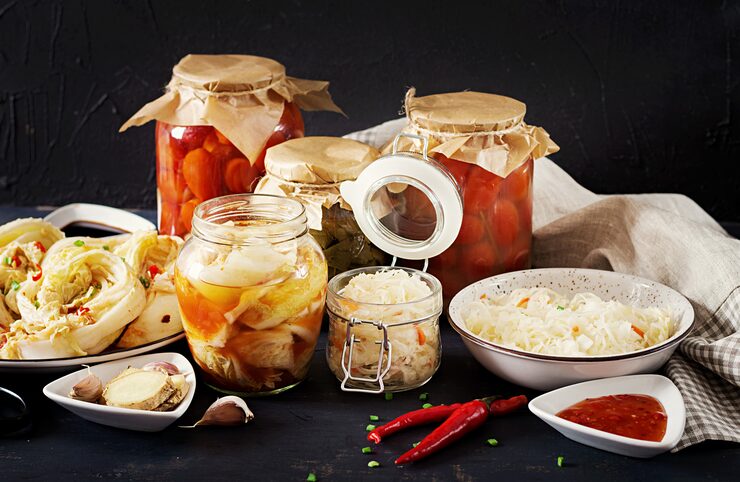Food Fermented Recipes are gaining immense popularity as health-conscious individuals seek ways to support gut health while enjoying rich, complex flavors. Fermentation, an ancient culinary technique, transforms ordinary ingredients into probiotic-rich, digestible, and flavorful foods that not only nourish the gut but also delight the taste buds.
Imagine a cozy evening at home with a bowl of tangy kimchi alongside a steaming plate of rice. The flavors are bold, and the gut-friendly benefits are undeniable. By integrating Food Fermented Recipes into daily meals, people can enhance digestion, strengthen immunity, and enjoy culinary diversity in one bite.
The Science Behind Fermentation
Fermentation is a natural metabolic process where microorganisms like bacteria, yeast, and molds convert sugars into acids, gases, or alcohol. This process not only preserves food but also enriches it with probiotics—live microorganisms that contribute to gut health.
Take sauerkraut, for instance. Shredded cabbage undergoes lactic acid fermentation, which increases its probiotic content. Regular consumption supports healthy gut microbiota, improving digestion and even influencing mood and energy levels due to the gut-brain connection. (Food Fermented Recipes)
Popular Fermented Recipes for Everyday Meals
A range of Food Fermented Recipes can fit seamlessly into breakfast, lunch, dinner, or even snacks. Yogurt, kefir, and miso are excellent for morning routines, offering protein, probiotics, and a creamy texture that complements fruits or cereals.
For lunch and dinner, kimchi, fermented pickles, and tempeh can enrich meals with umami flavors and digestive benefits. Imagine a stir-fry with tempeh cubes absorbing the flavors of garlic and soy sauce while simultaneously nourishing your gut. The combination of taste and health is a perfect example of functional cooking.
Creating Your Own Fermented Foods at Home
Fermentation may seem intimidating, but home kitchens are ideal for creating delicious and safe probiotic foods. Simple setups—such as jars, a clean workspace, and fresh ingredients—can yield a variety of recipes.
Start with cabbage for sauerkraut or cucumbers for pickles. Salt draws moisture from the vegetables, creating an environment conducive for lactic acid bacteria. Over days, the magic of fermentation unfolds, producing tangy, crisp, and gut-friendly delicacies. This hands-on experience also allows experimentation with herbs, spices, and seasonings, tailoring flavors to personal preference. (Food Fermented Recipes)
The Role of Fermentation in Modern Cuisine
Beyond health, Food Fermented Recipes elevate modern gastronomy. Chefs worldwide embrace fermentation to introduce depth, complexity, and natural preservation. Fermented sauces, cheeses, and even beverages add layers of flavor that processed alternatives often cannot replicate.
Restaurants experimenting with kombucha reductions, kimchi slaws, or miso-glazed vegetables showcase how ancient methods can complement contemporary dishes. Home cooks can also mimic these ideas, bringing restaurant-quality probiotic meals to everyday life.
Real-Life Benefits and Testimonials
Individuals incorporating fermented foods into daily routines often report improved digestion, reduced bloating, and more consistent energy levels. Consider a working professional juggling hectic schedules. Including yogurt parfaits for breakfast and a small portion of kimchi with dinner helps maintain gut balance, supporting both physical and mental well-being. (Food Fermented Recipes)
Parents also find fermented recipes useful for children, introducing probiotics in fun, palatable ways. Pickled vegetables, mild kimchi, or miso soup become tools for teaching healthy eating habits early in life, blending flavor and nutrition.
Pairing Fermented Foods with Balanced Diets
While fermented foods offer substantial benefits, combining them with a balanced diet maximizes their effect. Whole grains, fresh fruits, lean proteins, and healthy fats complement probiotics, ensuring the gut microbiome thrives.
For example, a bowl of quinoa with roasted vegetables and tempeh, paired with a side of pickled radish, provides fiber, protein, and probiotics in one harmonious meal. This integration underscores the versatility of Food Fermented Recipes in supporting holistic health.
Global Fermentation Traditions
Around the world, fermentation has been a cornerstone of cuisine. Korean kimchi, Japanese natto and miso, Indian idli and dosa batter, and German sauerkraut reflect cultural diversity while promoting gut health. Exploring these dishes encourages culinary adventure, introducing vibrant flavors and nutrient-rich benefits into everyday life.
Travel enthusiasts might seek out local fermented specialties, gaining cultural insight while benefiting from probiotics. The fusion of global flavors with personal cooking styles makes fermented foods an exciting, healthful addition to kitchens everywhere. (Food Fermented Recipes)
Innovations and Modern Twists
Modern innovations have transformed traditional fermentation into versatile, accessible recipes. Cold fermentation, kombucha brewing kits, and probiotic snack bars demonstrate how traditional methods adapt to contemporary lifestyles.
Tech enthusiasts might experiment with smart fermentation devices that maintain precise temperatures, ensuring consistent taste and optimal probiotic content. These innovations make Food Fermented Recipes approachable, practical, and exciting for home cooks of all skill levels.
Read also:
england cricket team vs india national cricket team match scorecard
new zealand national cricket team vs england cricket team match scorecard
afghanistan national cricket team vs australian men’s cricket team match scorecard
south africa national cricket team vs australian men’s cricket team match scorecard
dallas mavericks vs timberwolves match player stats
golden state warriors vs memphis grizzlies match player stats
dallas mavericks vs new orleans pelicans match player stats

